If you own a Samsung fridge, you may have noticed that sometimes the temperature display on the freezer door blinks with a number, such as 38. What does this mean and how can you fix it?
In this article, we will explain the meaning of the blinking code 38 on your Samsung fridge, the possible causes and solutions, and the potential risks associated with it.
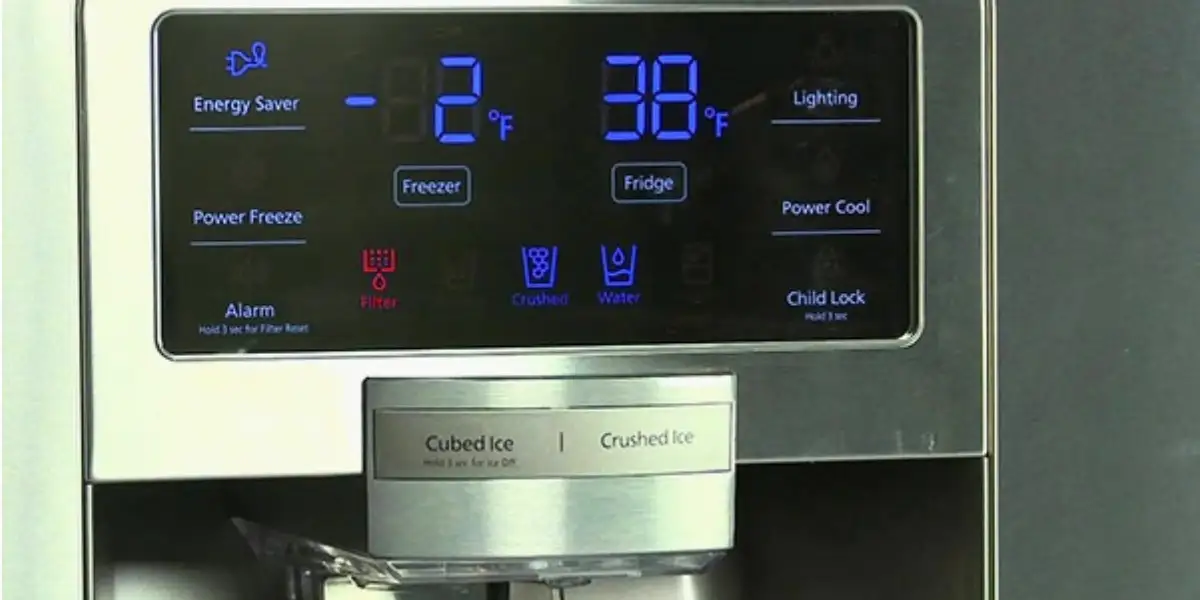
What Does Blinking Code 38 On My Samsung Fridge Mean?
A blinking code 38 on your Samsung fridge means that the freezer temperature is too high and the fridge is trying to cool it down.
It could also mean that the freezer door is not closed properly or that there is a problem with the cooling system.
The number 38 indicates the temperature setting of the freezer compartment in degrees Fahrenheit.
Why Is My Samsung Fridge Showing Blinking Error Code 38?
1. Defective or Damaged Fan Motor
The fan motor itself may be faulty or damaged due to wear and tear over time. Constant use or power surges can lead to its deterioration, resulting in the error code 38.
When the fan motor malfunctions, it cannot distribute the cold air evenly throughout the fridge, leading to temperature imbalances and inadequate cooling.
2. Obstructed Fan Blades
Sometimes, the fan blades can become obstructed by ice buildup or debris inside the fridge.
When the blades can’t rotate freely, the fan motor struggles to function correctly, triggering the error code 38.
This obstruction disrupts the airflow, impacting the fridge’s overall performance.
3. Loose or Disconnected Fan Wire Harness
The fan motor is connected to the fridge’s electrical system through a wire harness.
If the wire harness becomes loose or disconnected, the fan motor may not receive the necessary power to operate, leading to the error code 38.
Ensuring a secure connection is vital for the fan motor to work correctly.
4. Faulty Main Control Board
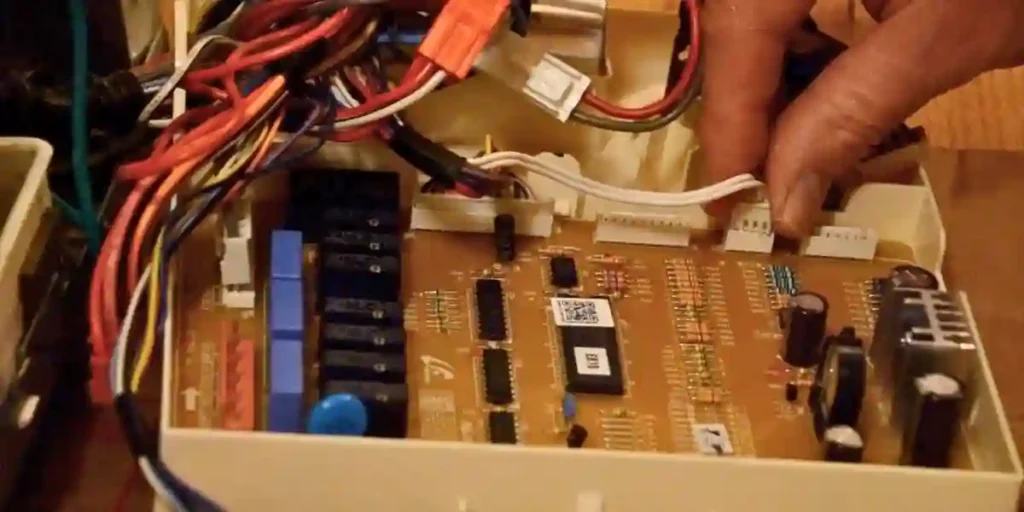
The main control board acts as the brain of the refrigerator, regulating its various functions.
If the control board becomes faulty due to electrical issues or component failure, it can misinterpret signals from the fan motor, causing error code 38 to appear.
5. Malfunctioning Temperature Sensor
The temperature sensor inside the fridge monitors the internal temperature and sends feedback to the control board.
If the sensor malfunctions or provides inaccurate readings, the control board may not adjust the fan motor’s speed correctly, resulting in error code 38.
6. Worn or Torn Door Gasket
A damaged door gasket can allow warm air from the surroundings to enter the fridge, causing temperature fluctuations.
To compensate for the rising temperature, the fan motor may work harder, triggering the error code 38 as a warning.
7. Improper Door Closing
If the fridge door doesn’t close properly or if there are gaps in the sealing, the fan motor may run continuously to maintain the desired temperature.
This constant operation can strain the motor, leading to the error code 38.
How Do I Troubleshoot And Fix The Blinking Error Code 38 On My Samsung Refrigerator?
To troubleshoot and fix blinking error code 38 on your Samsung refrigerator, follow these detailed steps:
Step 1: Power Cycle the Refrigerator
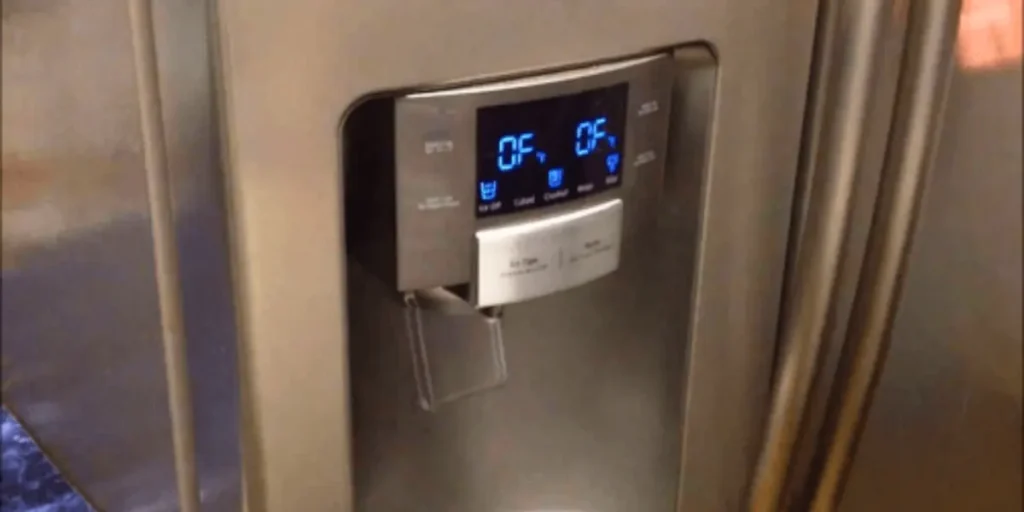
Start by unplugging the fridge or turning off the power at the circuit breaker for about five minutes.
This power cycle can reset the error code and clear any minor glitches, giving your fridge a fresh start. It’s a simple but effective way to troubleshoot the issue.
Step 2: Check the Fan Motor and Blades
Inspect the fan motor and fan blades carefully for any signs of damage or obstruction.
The fan motor is a crucial component responsible for circulating air inside the fridge, ensuring proper cooling.
If the fan motor is defective, damaged, or making strange noises, it may need replacement to restore optimal performance.
Additionally, check the fan blades for any ice buildup or debris that might be hindering their movement.
Use a soft brush or cloth to clean them if necessary, as this can greatly impact the fridge’s cooling efficiency.
Step 3: Examine the Fan Wire Harness
The fan motor is connected to the fridge’s electrical system through a wire harness. Verify the harness for any loose or disconnected wires.
If you find any issues, reconnect the wires securely to ensure the proper functioning of the fan motor.
A stable electrical connection is vital for the motor to work effectively and avoid error code 38.
Step 4: Inspect the Main Control Board
Carefully check the main control board for any signs of damage or burn marks. The control board is like the brain of the refrigerator, regulating its various functions.
If you observe any problems with the board, it’s best to contact a qualified technician to repair or replace it.
A malfunctioning control board can lead to misinterpretation of signals from the fan motor, causing error code 38.
Step 5: Test the Temperature Sensor
The temperature sensor inside the fridge plays a critical role in its functioning. Check it thoroughly for any signs of damage or corrosion.
The sensor provides crucial feedback to the control board regarding the fridge’s internal temperature.
If the sensor is malfunctioning or providing inaccurate readings, the control board may not adjust the fan motor’s speed correctly, leading to error code 38.
If necessary, replace the temperature sensor with a new one to ensure accurate temperature readings.
Step 6: Evaluate the Door Gasket
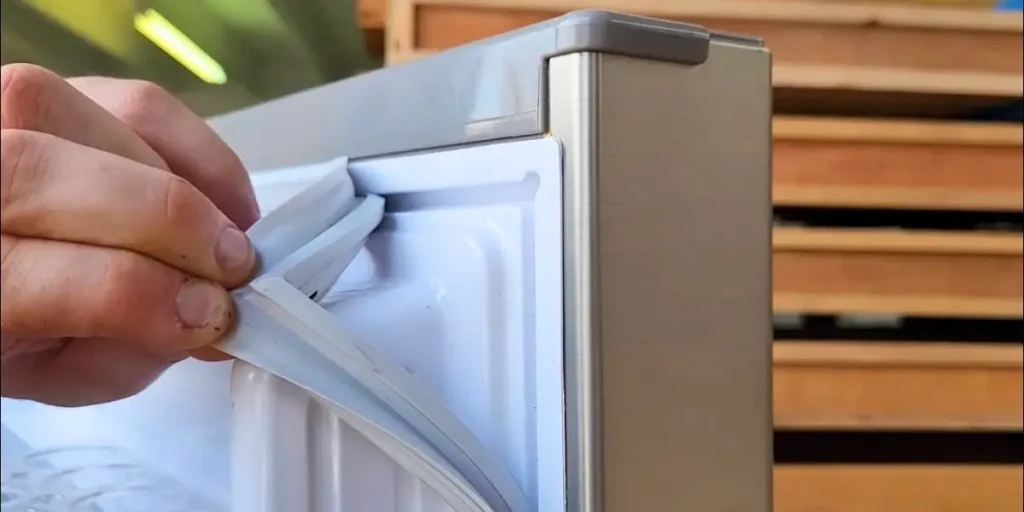
A worn or torn door gasket can be a common culprit behind cooling problems. Thoroughly inspect the gasket and replace it if needed.
The gasket forms a tight seal between the fridge door and the body, preventing warm air from entering and maintaining the proper temperature inside the refrigerator.
Step 7: Ensure Proper Door Closing
Check the fridge door to ensure it is closing correctly and forming a tight seal.
If the door doesn’t seal properly, the cooling efficiency can be affected, and the fan motor may work harder, triggering error code 38.
You may need to adjust the hinges or level the fridge to improve the door’s alignment and ensure a proper seal.
How can I prevent my Samsung fridge from showing blinking error code 38 in the future?
To prevent your Samsung fridge from showing blinking error code 38 in the future, you should
- Keep your fridge away from direct sunlight, heat sources, or humid environments that may affect its performance.
- Do not overload your freezer with too many items or open the door too frequently or for too long as this may increase the temperature and energy consumption.
- Clean your fridge regularly, especially the condenser coil, door seal, and ice maker, to remove any dust, dirt, or ice buildup that may impair its function.
- Check your fridge for any signs of damage or wear on its parts and replace them if necessary.
- Schedule regular service appointments with a Samsung technician to inspect and repair your fridge if needed.
7 Potential Risks Associated With Blinking Error Code 38 On Samsung Fridge
Higher energy consumption and noise
The fridge will use more electricity and produce more noise as it tries to cool down the freezer. This may increase your utility bills and disturb your peace.
According to the U.S. Department of Energy, a typical refrigerator consumes about 162 kWh per year, but this can vary depending on the model, size, age, and usage.
If the fridge runs more often than normal, it may consume up to 20% more energy. This can also generate more noise, which can be annoying or disruptive for you and your neighbors.
Food spoilage and waste
The freezer temperature may not be low enough to preserve your frozen food items, especially if the error code persists for a long time.
This may lead to food spoilage and waste, which can be harmful to your health and the environment.
According to the U.S. Food and Drug Administration, frozen food can be safely stored at 0°F or below.
If the freezer temperature rises above this level, the food may lose its quality, texture, flavor, and nutritional value.
It may also become contaminated with bacteria, mold, or toxins that can cause food poisoning or other illnesses.
According to the U.S. Environmental Protection Agency, food waste accounts for about 22% of municipal solid waste in the U.S., which contributes to greenhouse gas emissions and landfill problems.
Damage to the cooling system
The fridge may overwork the cooling system components, such as the fan, compressor, or condenser coil, and cause them to wear out or malfunction.
This may require costly repairs or replacements in the future. The cooling system is responsible for maintaining the optimal temperature and humidity levels inside the fridge.
It consists of several parts that work together to circulate refrigerant, air, and water through the system.
If any of these parts are damaged or defective, the cooling system may fail to operate properly or efficiently. This may affect the performance and lifespan of your fridge.
Fire hazard
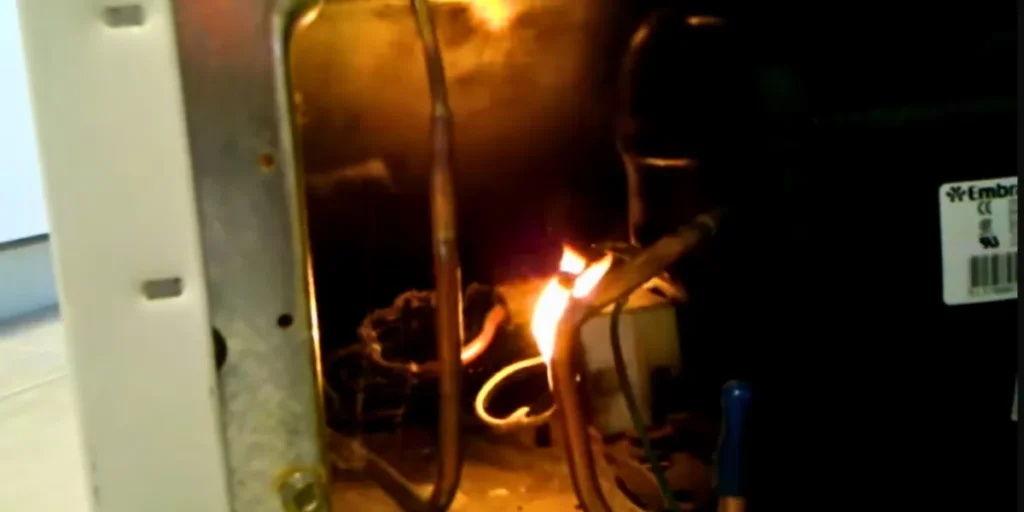
If there is a problem with the cooling system, such as a leak in the refrigerant circuit or a short circuit in the wiring or fuse, there is a risk of fire or explosion.
This can damage your fridge and other appliances and pose a threat to your safety and property.
According to the National Fire Protection Association, refrigerators were involved in an estimated 1,710 home structure fires per year between 2014 and 2018, resulting in 7 civilian deaths, 46 civilian injuries, and $44 million in direct property damage per year.
To prevent fire hazard, you should not attempt to repair your fridge yourself if you are not qualified or experienced, but instead contact a Samsung service center or a licensed electrician.
You should also install smoke alarms in your kitchen and test them regularly.
Water leakage
The fridge may leak water from the ice maker, water dispenser, or drain pan due to the high freezer temperature or a clogged or frozen drain line.
This may cause water damage to your floor, cabinets, or walls. The fridge produces water as it makes ice cubes or dispenses cold water.
This water is normally collected by a drain pan at the bottom of the unit and evaporated by a heating element.
However, if the freezer temperature is too high, the ice maker or water dispenser may malfunction and leak water inside or outside the fridge.
The drain line may also freeze or clog due to ice buildup or debris accumulation. This may prevent the water from draining properly and cause it to overflow.
Mold growth
The fridge may develop mold or mildew inside the freezer or on the door seal due to the high humidity or condensation caused by temperature fluctuations or air leakage.
This may affect the quality and freshness of your food and create an unpleasant odor. The fridge maintains a low humidity level inside the freezer to prevent frost formation and preserve food quality.
However, if the freezer temperature is too high or unstable, the humidity level may rise and cause condensation on the walls, shelves, or door seal of the freezer.
This moisture may provide a favorable environment for mold or mildew growth. The door seal may also deteriorate or crack due to aging or wear and tear.
This may allow warm air to enter and cold air to escape from the freezer, creating more condensation and mold problems.
Health issues
The fridge may expose you to harmful substances or bacteria due to the refrigerant leak, food spoilage, or mold growth.
This may cause allergic reactions, respiratory problems, food poisoning, or other health issues. The fridge uses refrigerant as a cooling agent that circulates through the cooling system.
If there is a leak in the refrigerant circuit, some of this gas may escape into your kitchen or living space.
Refrigerant can be toxic or flammable if inhaled or ingested. It may cause symptoms such as headache, nausea, dizziness, or skin irritation.
It may also damage the ozone layer and contribute to global warming. The fridge may also expose you to bacteria or toxins from spoiled or contaminated food or moldy surfaces.
These can cause infections or diseases such as salmonella, listeria, botulism, or asthma.
FAQs about Samsung fridge blinking code 38
How long does it take for the blinking code 38 to stop after I adjust the temperature setting or close the door properly?
It may take up to 24 hours for the freezer temperature to stabilize and the blinking code 38 to stop after you make any changes to the temperature setting or the door status. You can use a thermometer to check if the temperature has reached your desired level.
Is blinking code 38 a serious issue, or can it be resolved at home?
Blinking code 38 is not a very serious issue, but it can affect the performance and quality of your ice maker.
Do I need to empty the fridge contents when encountering blinking code 38?
You may need to empty the fridge contents during troubleshooting to access and address the potential issue related to blinking code 38 on your Samsung refrigerator.
Can power fluctuations trigger blinking code 38 on my Samsung refrigerator?
Power fluctuations can potentially trigger blinking code 38 on your Samsung refrigerator, especially if it affects the appliance’s electronic components.
Conclusion
A blinking code 38 on your Samsung fridge is a common issue that indicates that the freezer temperature is too high or that the door is not closed properly.
It can be caused by various factors, such as a power outage, a faulty thermostat, a dirty condenser coil, or a problem with the cooling system.
You can try to fix it by adjusting the temperature setting, making sure the door is closed properly, cleaning the condenser coil, or contacting a Samsung service center.
If you ignore this problem for too long, it may lead to food spoilage, ice buildup, or fire hazard.
Therefore, it is important to pay attention to your fridge’s performance and take good care of it.
Resources:
1. https://www.fda.gov/consumers/consumer-updates/are-you-storing-food-safely
2. https://www.lg.com/us/support/help-library/refrigerator-noises-CT10000021-20150292153479
3. NFPA
